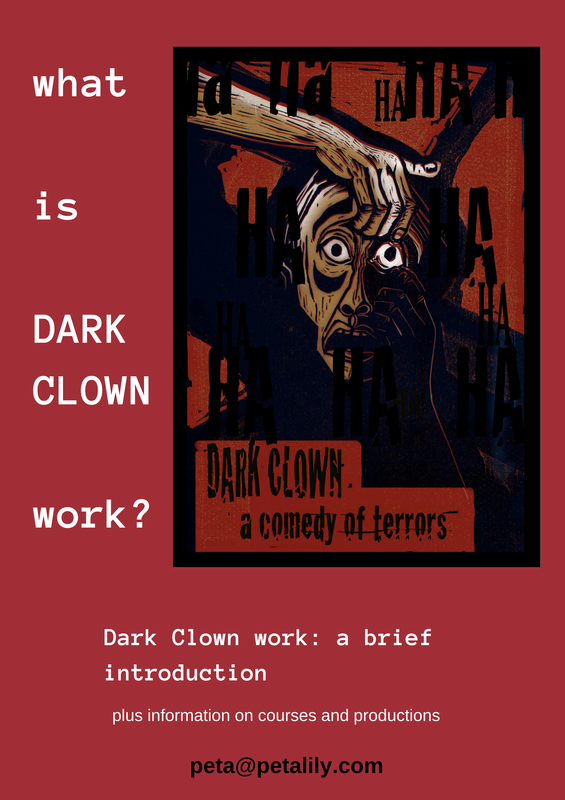After a recent evening class (for the wonderful Hoopla Improv company) a course participant asked for a recap of what Clown State is and how to access it.
An altered state - a mask state
Decades ago when I had the privilege to participate in a workshop led by Jacques Lecoq - he described the red nose as 'le plus petit masque du monde' (the smallest mask in the world) and a light switched on - Clown State can be approached as a mask state. See the wonderful Keith Johnstone's book Impro for more on mask state.
Occasionally one hears of people finding their 'inner clown' or having 'their own unique clown'. When teaching I find it is helpful to remove any pressure are anxiety these phrases might cause - 'what if I don't have an inner clown?!', 'what if I can't find it?'. Imagine rummaging in a dark cupboard - 'it's meant to be in here but where? where?!' People might think that they are creating their unique and precious inner clown, chiselling it carefully out from marble ... one wrong angle with the chisel and kkkkrrrrshhh!
The historical image of the unique clown-face makeup carefully painted onto a porcelain egg and placed inside a glass cabinet in a museum (a beautiful tradition with a pragmatic, copyright purpose), might lead someone newly learning clown to think they need to arrive at a fixed entity. I love to quote Angela de Castro: 'I have more than one Clown'.
Thinking of entering a Clown State is, for all these reasons, a useful thing. I feel it is helpful to see Clown State as a robust and elastic state of play. The concept of 'inner clown' works very well for many - but it might, to some, sound fragile, elusive, fixed, precious.
Here is what I use as a Clown State Process. I like people to have a 'before and after' so they can notice the changes for themselves. So I use a process of a series of steps. On and off. In and out.
Below this description of my workshop process are other methods to enter Clown State.
Normally when teaching Clown, right at the start, I get people to look into the eyes of the other - 'looking and seeing, making a connect'; but for the purposes of this process (the first several steps, at any rate), participants are invited to look only at objects and surfaces in the room.
1/ The instruction is: 'See things with potentially equal enthusiasm'. With the proviso that enthusiasm is not required, only a predilection, a favouring towards enthusiasm. Different things affect the clown differently - some things disappoint, some bore, some disturb, some are unexpectedly fascinating.
Participants are set off to do this task, then after about a minute I say 'stop doing that'. Participants then share in pairs. In plenary: Did they notice a change? Did they see anything that surprised them? Did they like anything? Did this feeling arise spontaneously? Did anyone have a problem? Trouble shoot.**
2/ As above, using the whole head to look - the eyes rest in their sockets.
3/ As above, but the whole torso moves to each new direction. If this starts to feel robotic, then stop and return to the head only.
4/ As above, with mouth open. (It's not a rule and does not need to be open all the time but it has an opening effect). Do for 45 seconds or a minute, then I again give the instruction: 'Stop doing that'.
Pair share to discuss experience. Plenary: trouble shoot. An example problem: some people don't like the 'stupid'* feeling that can visit when the mouth is open (or that comes with 'ears' below). On the other hand many love it and find it liberating. I remedy by giving an alternative such as the Genius Spark (see below). Brain chatter? If student experiences the inner narrative voice - return to step 1; if student experiences the Inner Critic voice, use the thought cancelling Homer Simpson 'Doh' or Goofy 'Unhuh!' mantras. Feel you have to be happy? - remember the full explanation of instruction 1. Feeling stilted or too normal? - did you leave out an emotional reaction? Were you bored or disappointed and did you try to push that emotion away / cover over it? It's great when emotions arise. Give emotions a sound and a shape. That's what the audience loves and benefits from - the humanity of the clown.
Some feel frustrated that this is a standing exercise - they want to run and touch - excellent, they can do that later! - for now, appreciate the spontaneously arising power of that incitement / compulsion as a gift of the Clown State!
Again the main points are:
that this is a different way of being to our everyday out-on-the-street 'normal';
that emotions and thoughts arise spontaneously;
that there can be Curiosity, Wonder, a sense of play or a meditative quality or a new level of feeling/sensing.
5/ All of the above plus Optional Added Extra: 'Think about your ears a lot'. If this instruction gets in the way, ignore it. Many find this hilarious or a beautiful and unexpected and almost magical lift to their awareness. I owe this instruction to the amazing teacher Monika Pagneaux.
Sometimes at this point I get people to take one tiny step out of that state. Sometimes I say 'step back like a hand coming out of a glove'. This is so that people can 'taste' the difference between the accruing state and the default composure of the self.
Stepping in and stepping out is a technique I learned from Mollie Guilfoyle, as applied in her mask and character work.
'Now step back in ... and make that 70% more vivid ... 90% more viivd ... adda sound, add a little movement with an elbow or a knee ... And gently step out again ... see how it was all there for you?
Stepping in and stepping out gives people and experience of Clown State as Altered State and also as something easily accessible. It can help people grow the facility to fully enter at speed, when needed.
I used to stop there - pair share and plenary trouble shoot, then have people re-enter the state and go on to ...
6/
Gently focus your attention on the undersurfaces of your body (see Avner the Eccentric's Principles). Use the underside of your feet, chin, armpits and also the lower surfaces of the inner organs, the brain and the eyeballs! Use the Hara.
7/ Somehow you begin to notice there are other beings in this room... no need to rush, take plenty of time to look. Looking is free. Allow yourself to have whatever emotion is there in the moment (with no obligation to name it). Emotions are all just passing through - emotions will come and emotions will go. This is common Clown teaching but I like that it relates to The Sedona Method as well.***
Might there be something about some aspect of another's clothing or hair that you think is genius? No need to invent it - but be open to the possibility.
Might there be something about some aspect of another's clothing or hair that maybe freaks you out a little bit? No need to invent it - but be open to the possibility.
What's it like to be part of this group?
What's it like to be seen by this group?
If there was a sound in this moment, what would it be? 1,2,3, GO.
Gently return to seeing objects and surfaces.
Step out of the state and return to whoever the heck you thought you used to be.
Pair share and plenary check-in.
I take care to point out that this experience is not a delineation of their clown (or their nascent clown) but simply an experience - one particular immersion into State on this particular day / in this particular moment.
Over time I have added a couple of extras or alternatives. I also mention to the group that there are too many instructions for any one moment - they are free to be open to allow the instructions to come in and out of consciousness in each moment.
8/ Close your eyes and imagine, that just in front of you is your Clown Heart. Go with your intuition - give it a shape and colour - allow this to occur to you intuitively, accept what you receive. Is it an anatomical heart? A cartoon heart? Is it made of candy floss? Is there a circus band / samba or salsa band playing in your heart?
Now step forward and make the heart part of you - or scoop it in with your arms. Breathe in to it. Notice how you feel. Slowly open your eyes and check that you can still feel it. Take a little run around the room. You still see from your eyes but it's as if you are seeing with your heart.
Troubleshooting: In the instance where someone feels some sadness when imagining the heart, it's good to remember that for clowning it is good to bring both your joy and your sorrow. If using the heart is not working for you, can focus instead on your Hara. Or you can wrap any sorrow in a pink cloud. Whatever is going on for the clown, their love for / community with the humans in the audience sustains them beyond their own tragedy.
9/ About 3 inches or 7 cm above the crown of your head is a spark. That is your Clown Genius (a good antidote /alternative to those who dislike feeling 'stupid').
10/ Another process that is helpful to people is the Funny Bone. Close eyes and imagine that somewhere in your body is your 'Funny Bone'. Go with the intuition of the moment. If you've chosen your left kneecap, great. Or might it be an imaginary free-floating bone in the shape of a dog biscuit? Find a space and all ow your Funny Bone to choreograph you. Start gently, but build your reuse and enjoy discovering moves inspired by your FB! On my workshops I play this music for the dancing. If you are in a group, fine partner and share your moves with them. Hand the focus back and forwards - be astonished, appreciative of your friend's inspired moves! Travel through the room together.
11/ Radiate - expand your sense of self beyond your own skin - maybe imagine a pink cloud. I have begin teaching The Sponge. Imagine your whole body is a sponge. Move round the room absorbing the vibe if the air, the objects and surfaces in the room. Stop and notice how it felt. Do it again, Another phrase I use when coaching trainee clowns is 'separate your molecules'. This instruction is meant to help create a sense of spaciousness - it can also help to release their 'surface tension' and open more, in order to cultivate a physical readiness and a responsive attitude.
Pick and Mix
Obviously one cannot think of all these at once, feel free to test and try, find what works for you and / or to allow the mind to switch between them.
Stepping In and Stepping Out
Respect Clown State. As you immerse into clown state, every so often step out: in the room I give the instruction: take a step out to one side, glide out, like a hand gliding out of a glove. Notice the 'normal' of performer's 'neutral' a well-balanced position of alignment and settled breath. Notice the difference and step back in. Once you've done this a few times you can access Clown State just by Stepping In. When doing exercises in a room. Enter Clown State, and when the exercise is done, either exit the performing space and/or turn you back and 'step out'. This helps beginners know Clown is an altered state than can be entered and then stepped out of.
Stepping out was invented by Susan Bloch. See her book.
Those who do my Alchemy of Archetypes course will know I use it there. It's also helpful for the Dark Clown work, too.
John Wright's Bafflement exercise
Thanks to Holly Stoppit and Robyn Hambrook's wonderful Clown workouts initiative, I got to hear about a method John Wright uses. It's called 'Bafflement'.
Here is the how-to: Think of the area on the back of your head. This helps you into a wider brain function than the everyday reality that likes us to keep our brains in the language- and logic-based neo-cortex (I am not a scientist, but at a metaphorical level, this seems to feel right/useful). Put your attention on the back surface of your head, now use this mantra: 'I don't know what I'm doing and it's ok.' Try it, then go play!
To Nourish Your Clown
a. Try the wonderful Holly Stoppit's Clown Paradise journey.
b. Or try this exercise - I call it: 'A World of Possibility' - get into Clown State and look into the air - use your intuition and see and opening - is it a window? open it and climb through - find yourself in a room or environment - is it all made of grass? Or is it full of marshmallow furniture? stay as long as you like, then look again and see an opening (maybe it's a curtain or a door or a porthole - maybe sometimes you see a ladder or a trapdoor) each portal takes you to another environment. The final door or portal brings you back into the room you started in - stay in Clown State as you look at the space you are in afresh - how does it seem now? Take all the time you need to 'return' to the room. And when you are ready, step out of clown state. When I do this in a room, I use this music. (It's a wonderful album, consider buying it - I did).
General conditions for Clowning and 'Life-full-ness'
Before getting to this stage I use numerous games and instructions to release tension, prime the body and breathing, to get people connected and people into open play state and to find a simplicity in their physicality.
Many of these instructions I received from the amazing movement teacher Monika Pagneaux, when she was working with Philippe Gaulier. Monika works with Feldenkreis technique and has collaborated with Peter Brook - but also has her own unique rich and fulfilling processes to bring bodies and spirits to what she calls 'lifefull-ness'.
* I often say that the Clown's 'stupidity' is an alternative intelligence.
** There are many extra observations, distinctions and teaching points around all this - these are the bare bones of the process which works for 99.998 percent of the people I have taught.
*** The Sedona Method book is on my useful book list, which I am continually updating and which I share with workshop graduates.
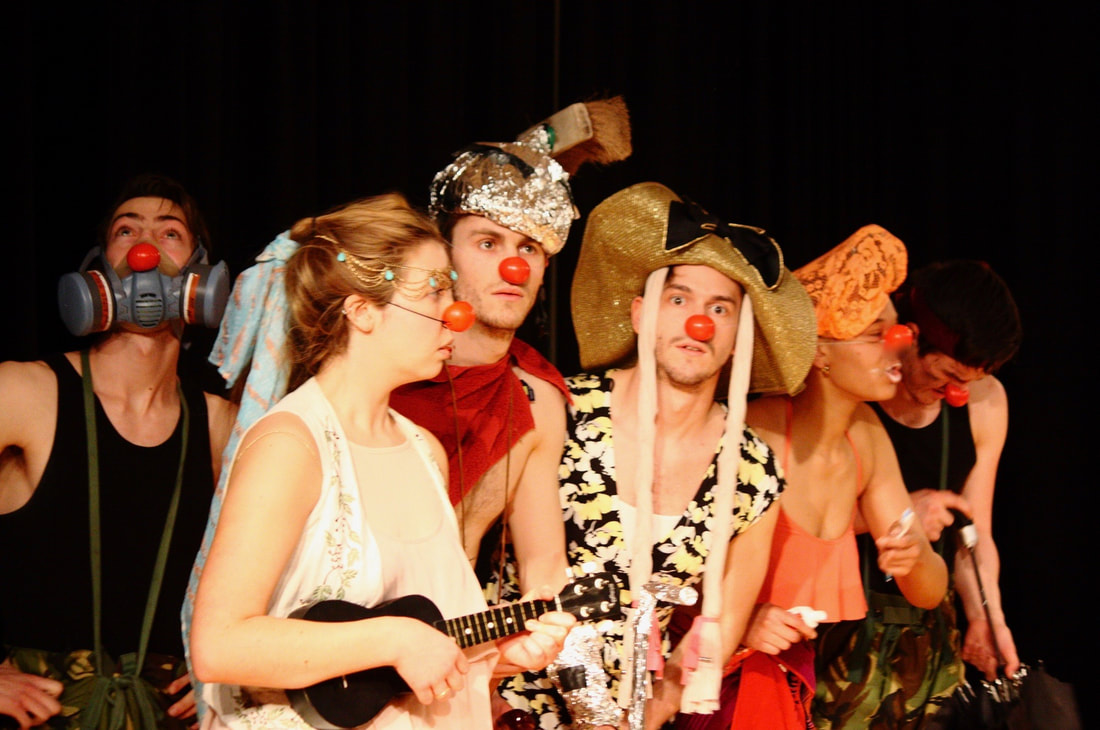
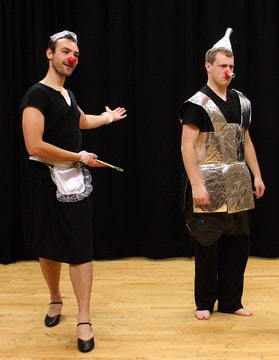
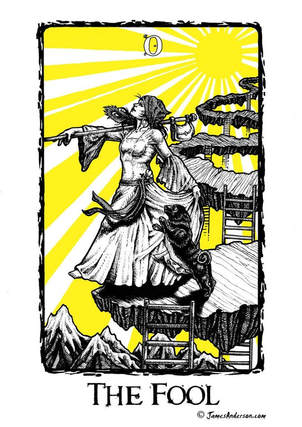
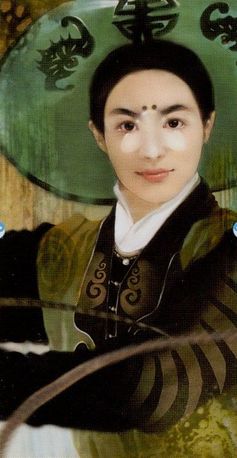
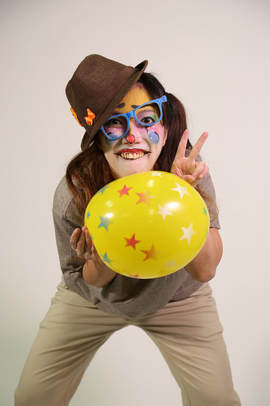
 RSS Feed
RSS Feed
